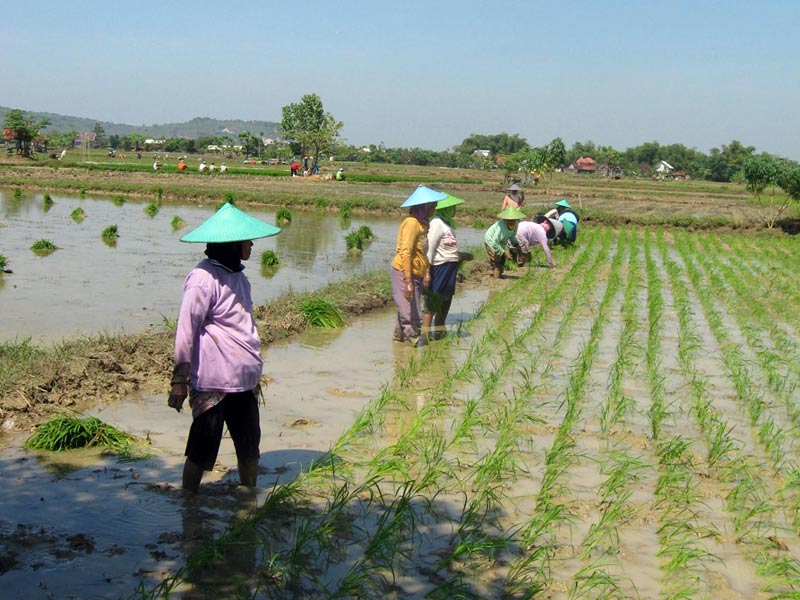
At the end of September, the fields were ripe for harvesting. Rice, peanuts, corn and vegetables were ready in Palang, East Java. Although Palang is a dry and chalky district, the farming communities are keen to improve their land. By using water pumps to irrigate the land, they are not so dependent on the wet season. They can grab every opportunity to plant and cultivate second crops.
THE RISING COST OF FUEL
There's no time for rest in improving the soil. When the rice harvest is finished they must immediately start preparing the soil for the crops that follow, namely rice, peanuts and corn. Of these crops, rice demands the most water. In one planting season wet rice fields need to be flooded ten times. Each of these irrigation cycles requires seven litres of diesel to fuel the water pumps, so over ten cycles they need 70 litres of diesel at a cost of Rp. 455,000 (~US$41). The cost of fuel went up this year, straining the meagre profit margins of many farmers.
Peanuts only require two thirds of the total diesel fuel needed for growing rice, so the cost of fuel is Rp. 318,000 for 50 litres of diesel. However, the profit from peanuts is far greater, and they are easily sold to big companies in Central Java.
RESOURCEFUL FARMERS
Pests such as mice add to the challenges faced by rice farmers. However the people of Ngaglik village have a unique way of chasing away mice by using the fruit of the mengkudu (noni) tree. Both the ripe and unripe fruit is cut up very fine and spread across the wet rice fields that are ready for harvesting, and inserted into the holes where the mice nest. This is very effective in driving mice away, because the smell of the fruit makes the mice intoxicated and sends them scurrying.
It isn't just rice, corn and peanuts that are planted. Some people in Palang, in the villages of Glodok and Leran Kulon, also plant vegetables such as kangkung, mustard greens, amaranth and eggplant. Resourceful farmers are improving corn production by using a very simple corn husker, modifying a carpentry plane by replacing the blade with blunt nails.
The Kopernik team have been working with the manager of the Cendoro LPM D (Villagers' Empowerment Organisation) to trial rice harvesting tools in north Cendoro. Farmers normally harvest rice by hand using a simple scythe, a process that is both labour-intensive and physically demanding.
NEW TECHNOLOGY
We introduced a paddy mower to see if this would make harvesting rice easier.
The model we trialed comes from China, but we sourced it from Surabaya at a total cost of around US$500. At this price, it is a technology that would most likely be rented to farmers, or that a farming cooperative might buy to be shared among the group, in a similar way to how other farming technology like hand tractors and water pumps are used. The paddy mower is fueled by petrol, using about three litres of petrol in two hours. We watched an instructional video and shared the manual with the farmers, and then we were ready to start the trials.
Although the using the paddy mower is less physically taxing then harvesting rice by hand, we have found that farmers are not instantly adopting this technology. While they normally hold the scythe in their right hand, with the paddy mower they control the power with the right hand and harvest with their left hand. The position of the on/off button at the base means the machine can easily be turned off accidentally, so it has to repeatedly be restarted. Another drawback: the blade became blunt quite quickly. We have shared this feedback with the distributor, and while we are continuing trials, we are also looking for other more suitable models.
It is interesting to note that although women are very involved in harvesting rice by hand, we couldn’t find any women who were interested in trialing the paddy mower. Women have been very interested in the hand-cranked corn sheller that we have introduced at our technology fairs. We are looking for a manufacturer interested in producing the sheller locally, as the trial model comes from Tanzania. We have also introduced organic fertilisers, and we are looking for land to trial simple drip irrigation technology.
By introducing these technologies, we hope to make life easier for the many families dependent on agriculture in this part of East Java.
Much of the rice farming in East Java is done by hand
Some farmers in Palang rent hand tractors
We introduced a paddy mower to see if this would make harvesting rice easier


